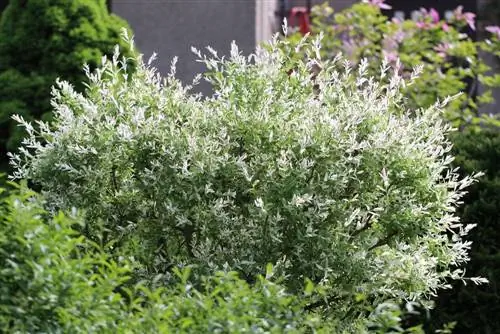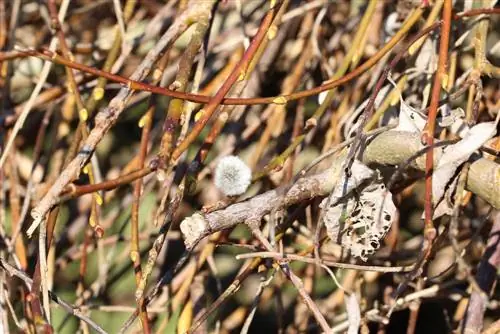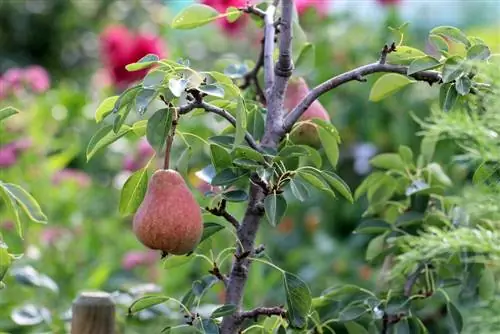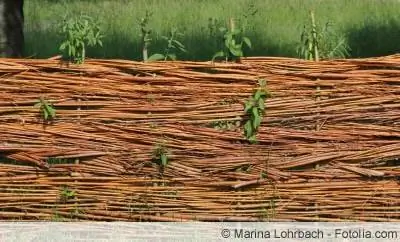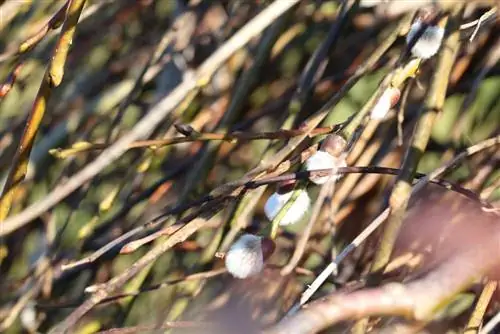- Author admin [email protected].
- Public 2023-12-17 03:39.
- Last modified 2025-01-24 12:45.
The dwarf willow, Salix arbuscula, is undemanding, easy to care for and hardy. This makes it a perfect alternative to the lushly growing weeping willow, even for smaller gardens, especially since it can even be kept in a pot. Visually, Salix arbuscula is just as attractive as the weeping willow, but it can even be kept on the balcony or terrace as it maintains manageable dimensions in terms of size and height and can also cope with vigorous pruning.
Location
Dwarf willows have an extremely high need for light. This should be taken into account when choosing a location. If the dwarf willow is placed in a shady or semi-shady location, it can easily have sparse foliage. A sunny location or at least one with light partial shade is optimal.
The most important location requirements:
- bright location
- sunny or at least partially shaded location
- a shady location leads to sparse foliage
Substrate
In general, Salix arbuscula is relatively undemanding when it comes to substrate. Normal garden soil is sufficient for the plant to thrive. However, the soil should be loose and nutrient-rich and also be able to store water well. If the dwarf willow is free in the garden, it makes sense to mulch the soil regularly. You are also doing the pasture a favor if the soil is regularly enriched with compost. If, on the other hand, the dwarf willow is in a pot, then it should be kept in high-quality pot soil with additional mulch.
Repotting
Repotting the dwarf willow is uncomplicated. If the pot is no longer of sufficient size or the location in the garden is unsuitable in the long term, the willow can be transplanted into a sufficiently large hole, which should be three times as deep and as wide as the root ball, with suitable substrate. If the dwarf willow is already relatively large, repotting becomes a little more complicated because it has now developed a large root ball that should be moved as undamaged as possible. Within the first three years, it is sufficient to cut off the roots of the young plant at a distance of one meter from each other. The plant should then be prepared by first digging a trench around the trunk and filling it with compost. After about six months, the dwarf willow will be ready to move. This procedure can support the development of fine roots in older plants, which promotes growth in a new location.
Ideal repotting conditions:
- young plants can easily be repotted into larger pots
- Older plants should be prepared for six months by digging a trench.
- The new planting hole should be three times as wide and high as the root
Pouring
Watering the dwarf willow is uncomplicated. If the dwarf willow is established in the garden and the soil is sufficiently mulched, then it does not need regular watering. Watering should only be carried out as needed in hot months. Young plants that are not yet fixed in the ground need regular watering, as do plants grown in containers, as do plants that are in substrate without mulch. What the plant values most is soft, low-lime rainwater or, alternatively, stale tap water.
Tip:
If there is persistent drought and you want to save water when watering, you should dig a narrow ditch around the pasture. This so-called watering edge ensures that the roots are supplied more specifically and water can be saved.
Fertilize
Like watering, fertilizing is only necessary to a limited extent with Salix arbuscula. Potted or container plants naturally have fewer nutrients due to less substrate available and should be fertilized regularly. It makes sense to use a liquid fertilizer for ornamental shrubs that supplies the necessary nutrients every four to six weeks. When the willow is left free in the garden, the roots have the opportunity to spread and absorb more nutrients. Therefore less fertilizer needs to be used. Especially when mulch has been mixed into the substrate, the need for fertilizer is reduced enormously. Fertilizing once in spring and again in summer makes sense. A liquid fertilizer for shrubs and trees can also be used here.
Tip:
From September onwards, the pasture should no longer be fertilized. Otherwise the branches cannot mature enough and they may not survive the winter without damage.
Cutting
Unlike many other trees, the dwarf willow can not only be thinned out in February or March, but also cut back by a third or half using pruning without the growth habit being negatively affected. So that it maintains a beautiful shape, it should also be pruned once after sprouting or in autumn, in which only the new shoots are cut back slightly. The best tool for cutting is a hedge trimmer. In order for the dwarf willow to maintain its perfect shape throughout the year, it must be cut occasionally in the summer because it grows very quickly. The dwarf willow does most of the work in terms of care when it comes to cutting. Be careful from March to September as there could be bird nests in the pasture!
Wintering
An adult plant is frost hardy and survives the winter independently and without support. It is therefore usually not necessary to protect the plant against cold. However, the dwarf willow as a young plant and in a container needs protection in harsh winters. The insulation can be implemented using garden fleece, brushwood, straw or even boards. You should not use foil as cold insulation as it does not allow sufficient air exchange.
Propagate
The dwarf willow is propagated using cuttings. To do this, you use some of the plant's shoots in spring or summer that are left over from cutting. The shoots should be 15 to 20 cm long and cleanly separated. An oblique cut with a large area promotes root formation. The shoots are placed in a dark, opaque container filled with water about three fingers wide. Then place the cuttings on the windowsill or in the winter garden in a bright and moderately warm place. After a few weeks, individual roots and new leaves appear. The cuttings can then be planted in potting soil. It is perfect to keep the cuttings in the pot for the first two to three years. In addition, the young cuttings must be frost-free and safely overwintered during this time.
Diseases and pests
Salix arbuscula is actually very robust. Exceptions are fungal infections such as rust or the so-called willow anthracnose and the willow leaf beetle, which can attack the willow. The infestation by the willow leaf beetle can be recognized by signs of feeding until the pasture is completely bare. The beetle also leaves behind orange egg deposits. Birds like to eat the beetles, so even a bare pasture can regenerate completely without further support. If you want to stop the beetle infestation more quickly, you can use insecticides. Regularly checking the pasture for beetles or egg laying offers the opportunity to quickly stop the infestation.
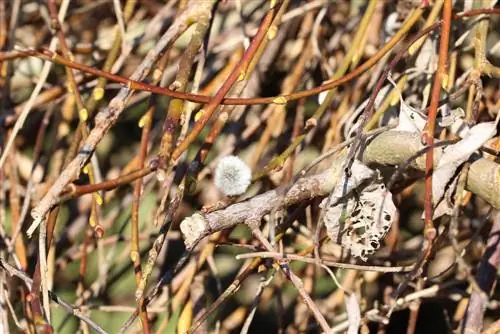
Fungal infestation results in wilted leaves or brown and black discoloration. Here the affected areas must be generously removed and, above all, destroyed. The parts must not end up in the compost to prevent the spread. A fungicide is then used to stop the fungal infection.
Frequently asked questions
Is the dwarf willow poisonous?
Salix arbuscula is not poisonous in itself, but it can be problematic for small pets. The shoots and bark contain tannins that can cause digestive problems. Rabbit or guinea pig owners should keep the animals away from the plant or at least limit their intake of the substances to very small amounts.
What do dwarf willows suit in the garden?
The dwarf willows are very suitable in combination with rock garden plants. Alpine perennials are perfect partners for the dwarf willow. In the larger rock garden, the willows can also be combined with subalpine or subarctic plants. The willows also get along very well with these plant species in troughs.
What you should know about the dwarf willow in brief
- Of the approximately 300 known willow species, quite a few also occur in arctic or alpine zones.
- Adaptation to unfavorable location and climatic conditions also led to prostrate or shrubby growth in numerous willow species.
- Around 30 dwarf Salix species occur in the arctic-alpine zones of Europe alone, some of which have a circumpolar distribution.
- With a few exceptions, dwarf willows are not yet very widespread in the garden.
- In the appropriate environment, in heather, rock and trough gardens, some species are extremely decorative, almost indispensable.
- Others have already proven their value as ground cover. In addition, dwarf willows are currently popularly grafted onto standard stems.
- Most willow species are able to survive under very different environmental conditions.
- All willows are extremely light-requiring. When choosing the planting site, this location requirement must be met.
- In shady or sunny places, all willow species quickly lose their natural habit, they build up more loosely and have sparse leaves.
- Dwarf willows are particularly welcome in the rock garden, as they nestle closely to the base with their mat-shaped growth. They are ideal partners for alpine perennials.
- Slightly taller, shrubby species from subalpine or subarctic zones also find their place in larger rock gardens.
- The same species are usually also used to plant larger and smaller troughs.
Mat-shaped dwarf willows
- Herb willow: with underground, initially non-woody runners, the above-ground branches as thin short shoots with few leaves. The herbaceous willow is only 5 cm high and since it also thrives in dry locations, it is suitable for trough planting as well as rock garden planting.
- Net willow: branches are pressed to the ground and have roots, the shoots are relatively thick, bare and with large buds. The net willow thrives in fresh locations, in rock gardens and in troughs that are kept sufficiently moist. With the peculiar leaf, a very distinctive, decorative dwarf willow.
Dwarf willows with prostrate branches and rising shoots
Alpine willow: the alpine willow is a low shrub with branches pressed to the ground and ascending shoots. The alpine pasture is ideal for rock and trough gardens
Shrub-shaped, foot- to waist-high dwarf willows
- Sapling willow: the Sapling willow is a richly branched and densely leafy shrub, 30 to 50 cm high and of various shapes, upright, bushy or prostrate. The dwarf willow is suitable for individual placement in rock and heather gardens. It loves moist to dry places and prefers nutrient-rich soil.
- Spike willow: The spit willow is a highly branched shrub up to 1 m high with dark gray shoots and bare buds. The spit willow is a very decorative willow for individual placement in rock and heather gardens; it grows in moist to fresh places, on acidic and calcareous soils.

